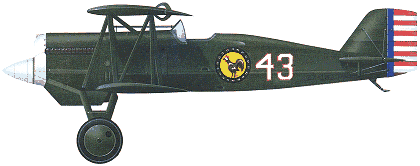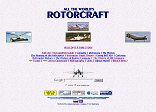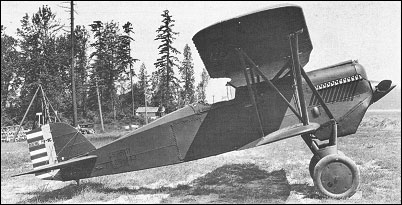|
| With experience gained from sub-contract production of a variety of aircraft designed by other manufacturers, and in particular, the Thomas-Morse MB-3A, Boeing began the private-venture development of a single-seat fighter under the designation Boeing Model 15. First flown on 2 June 1923, it was a single-bay biplane with wings of unequal span, the lower wing also being of reduced span and chord. The wings were of wooden construction, fabric-covered, but the fuselage was of welded steel tube. The braced tail unit was also of wood, and incorporated a variable-incidence tailplane that could be adjusted in flight. Landing gear was of fixed tailskid type, with through-axle main units, and. power was provided by a 324kW Curtiss O-12 inline engine.
The US Army had become interested in the Model 15 before it was flown, and after early tests by Boeing it was evaluated by the US Army at McCook Field, under the designation XPW-9. There it was flown in competition against a Fokker XPW-7 and the Curtiss XPW-8A, its performance proving good enough to win an order for two extra XPW-9s for more extensive evaluation; these were delivered in May 1924. The third of the aircraft differed by having divided-axle instead of through-axle main landing gear units, and it was this type of landing gear that was chosen for the 30 examples of the production PW-9 ordered in two batches (12 and 18) in September and December 1925 respectively.
The US Navy was as keen as the US Army to acquire examples of Boeing's new fighter, and the first of an order of 14 for service with the US Marine Corps, under the designation FB-1, was delivered on 1 December 1925. Only 10 were produced as FB-1s, these being virtually identical to the US Army's PW-9. The 11th and 12th aircraft on this order introduced the 380kW Packard 1A-1500 inline engine, and were equipped with through-axle landing gear and an arrester hook for operation from aircraft-carriers. The change resulted in redesignation by the US Navy to FB-2 (Boeing Model 53); the 13th aircraft was identical to the FB-2, except for twin , float landing gear, and was designated FB-3 (Boeing Model 55); and the
14th and last of the US Navy's initial order also had twin floats, but introduced a 336kW Wright P-1 radial engine, becoming redesignated FB-4 (Boeing Model 54) or FB-6 with the 298kW Pratt & Whitney Wasp.

 | A three-view drawing (1278 x 918) |
| Frank Donovan, e-mail, 24.01.2024 06:19 I am so happy to have consulted RAPID RESCORE CREDIT for my credit repairs. I discovered that I had 5 negative items on my credit most especially IRS, delayed payments and loans and over 7 hard inquiries from every bureaus and it hindered me from moving forward in my business. I could not access any loan so I started looking for ways to salvage my condition, I then discovered this specialist (RAPID RESCORE CREDIT) on reddit though there were other ones there but my instinct directed me towards Mr Jackson. I was asked for funds to get started with the job and I gave them the benefit of doubt and made some commitments. My fico score was moved from 609 to an excellent score (799) and all the negatives were deleted from my report. Right now I have a clean profile with wonderful trade lines. I’m recommending their services to anyone in dire need of credit fix, you can reach them via JACKSONRAPIDCREDITSCORE@GMAIL.COM reply | | Patrick Burnside, e-mail, 13.01.2024 01:05 Here's how I raised my FICO score from 430 to 785. My diabetic condition caused me to fall behind on my medical bills, which caused my world to fall apart. I searched high and low for someone who could help me repair my credit, but to no avail. In November of last year, I met JERRYLINK CREDIT GROUP through a friend they had worked for; they restored my dignity and boosted my credit in 9 days, allowing me to take out a loan and pay for a house. You can reach them at JERRYLINKGROUP@GMAIL.COM or via TEXT at +1 626 514 0620 reply | | Beverly Juan, e-mail, 16.12.2023 03:32 How do I recover $222,500. BTC sent to a romance scammer?
It's possible to get back your money little I know it was a big shock of my life because the company i sent my money to was revealed to be a total scam.
I contacted the professional and they helped me with the recovery of all my money successfully, you can also contact them for help. They will help you retrieve back your money, I was able to retrieve all my money back through the professional, you can contact them too they are ready to help....
Email Address: dwchzone@gmail.com
Whats-App: +1 (803) 392-1735 reply | | Barbara Walter, e-mail, 13.12.2023 23:19 Fixing my credit with the help of H A C K M A V E N S CREDIT SPECIALIST was the best thing that has happened to me this year, it was fast and easy. At first, I thought it to be a scam, but they proved me wrong by shooting up my F I C O score from 553 to 785, cleared all outstanding debt worth $25,000 and cleared derogatory, repossessions, and collections from my credit profile in less than 8 working days. All I did was contact them through the contact details I got from other good reviews about them online EMAIL: H A C K M A V E N S 5 @ G M A I L. C O M or Call /Text /WhatsApp: [+ 1 (2 0 9) 4 1 7 - 1 9 5 7]. Thank you!! reply | |
| | Morgan Kennedy, e-mail, 10.12.2023 08:23 Mr. Jerry and I have worked together for many years now in a professional setting. I am a realtor and have clients in various stages of credit repair. Mr. Jerry is ALWAYS the person I recommend to my clients. His services are second to none & he has always done the best job in order to get my clients in a home as quick as possible when credit is holding them back. He has helped my family members, friends, & strangers I have met through my services. Thank you Mr. Jerry for caring about people like you do! You are making a difference!!! Reach out to Jerrylink Credit Group via: jerrylinkgroup@gmail.com or text 6265140620. Thank me later. reply | | Grace Peterson, e-mail, 02.12.2023 03:54 I strongly JERRYLINK CREDIT GROUP: I think they are the best in terms of credit repair. I had worked with different credit companies in the past, but there was no significant change on my credit report. So many credit forums recommended DYI, I tried every credit hack in the book all o no avail. A real estate agent introduced me to Mr. Jerry, who has been helping his clients. Mr. Jerry and his team helped me erase all the negative things on my report, and raised my score to excellent score across all three bureaus. I’m recommending as promised. They are available on gmail: JERRYLINKGROUP AT GMAIL DOT COM or +16265140620 reply | | Leon Cody Garcia, e-mail, 28.11.2023 22:59 We will fix your credit; remove all negative items, clear loans, collections and hard inquiries and also raise your score to 760+ ASAP. These were the exact words from M. Jerry when I contacted him via JERRYLINKGROUP at GMAIL dot COM. I decided to give JERRYLINK CREDIT GROUP a try and to my greatest surprise it worked out for me. In less than 11days after all documentation; my score drastically increased to 810 across the three national credit bureaus (Equifax, Experian and TransUnion), I could no longer sight evidence of collections, negative marks, mortgage loan, collections and hard inquiries on my credit report. I honestly appreciate Mr. Jerry for fixing my credit. reply | | Greg Herrick -- AFA, e-mail, 05.07.2016 17:20 From Larkins "The Ford Tri-motor" here are additional details: April 21, 1929, San Diego, CA, Ford NC-9636 [Serial Number 5-AT-10, Model 5-AT-B, First Flight 12-6-28, Delivered 1-4-29 to Maddux Airlines]. The Maddux Airlines Ford 5-AT-B on its way from Dan Diego to Phoenix was hit in mid-air by Air Corps Boeing PW-9D, Serial No. 28-37, which turned from right to left directly in front of the airliner. Pilot Howard W. Keefer on the 95th Pursuit Squadron was killed when his half-opened parachute caught on the tail of the fighter. All aboard the Ford were killed when the plane hit the ground upside down at a 45 degree andle. Pilots Maurice H. Humphry and Louis Pratt. Passengers Arturo and Amelia Guejardo, Cecilia Kelley. see: SD319, 71st Congress, 3rd Session, Senate Document 319 "Aircraft Accidents Between May 20, 1926 and May 16, 1930; New York Times, 4-22-29 page 1; San Francisco Chronicle 4-22-29, page one. reply | | Greg Herrick -- AFA, e-mail, 05.07.2016 17:06 Here is one notation concerning this accident: On April 21, 1929 a Maddux Air Lines Ford 5-AT-B Tri-motor was involved in a midair collision with a single-engine U.S. Army Boeing PW-9D pursuit biplane near San Diego. Shortly after taking off from San Diego, the airliner was flying at around 2,000 feet on its way to Imperial Valley, California, when the pilot of the biplane buzzed the airliner and, misjudging its speed, collided with it. The army pilot, Lieutenant Howard W. Keefer, tried to bail out of the wreckage, but his parachute got entangled, and both aircraft crashed near the Lexington Park subdivision of eastern San Diego on the side of a canyon. All five people aboard the Tri-Motor and the Army pilot, who was found "criminally negligent" for approaching the airliner, died in the crash. This was the first midair collision involving a U.S. airliner. reply | | Barry, 03.03.2016 12:33 Span 32'0" Length 23'5 Height 8'2" Empty Weight 1,936 lb
Loaded Weight 3,120 lb
Maximum Speed 159 mph Cruising Speed 142 mph
Service ceiling 18,925 ft Range 390 miles
Armament 2 x .30 machine guns and 1 x 244 lb bomb reply | | Karl Moore, e-mail, 02.04.2014 22:49 Note latest email address! reply | | Karl Moore, e-mail, 22.09.2009 00:08 I was 6 days old when this crash happened just a few blocks from the house where I was born. Lt Keever was stunting over the Ford Trimotor which was a practice of military pilots in those days. He miscalculated and struck the trimotor between the left and center engine decapitating the pilot. Le Keever tried to bail out but his chute was caught on the PW9 and he was dragged to his death with his aircraft. I have been collecting anything on this crash for the last few years. I have visited what I believe to be the present site of the crash just above the Wabash freeway in San Diego. I would like any more information you might have and am willing to trade what I have. Karl reply | | Karl Moore, e-mail, 26.05.2009 04:45 Examples of the PW-9D were stationed at Rockwell field,
North Island in San Diego in 1929. One colliding over San Diego with a Ford Trimotor airline operated by Maddux Airlines. The pilot and all 6 passengers of the Trimotor
perished. I believe the PW-9D pilot, Lt. Keever was with the 95th Squadron, USAAF.. Source: San Diego Union newspaper, April 21, 1929. reply |
|
Do you have any comments?
|
| 
COMPANY
PROFILE
All the World's Rotorcraft
|








